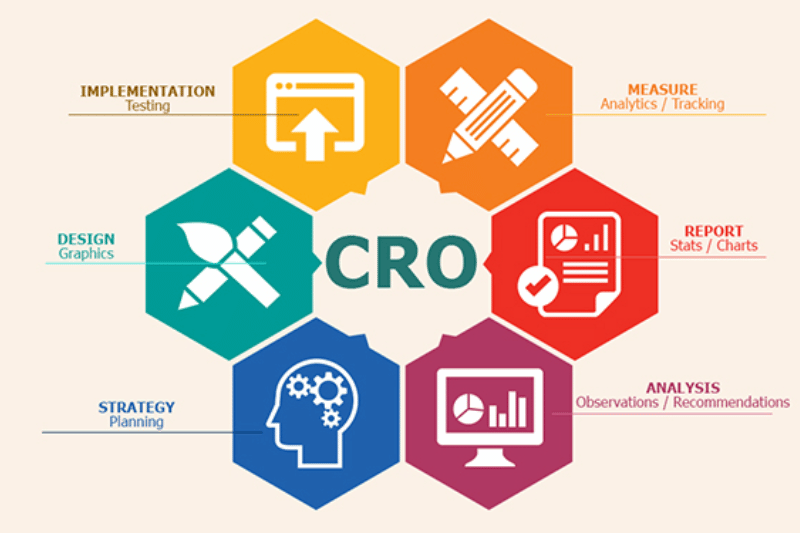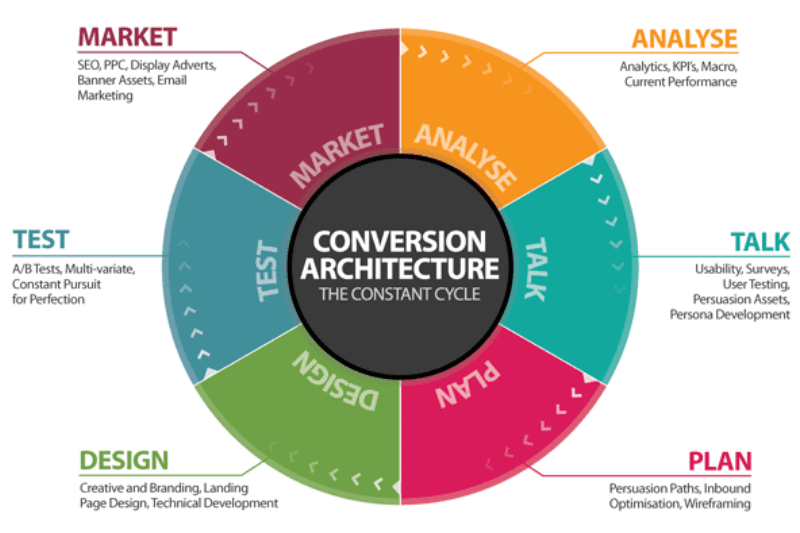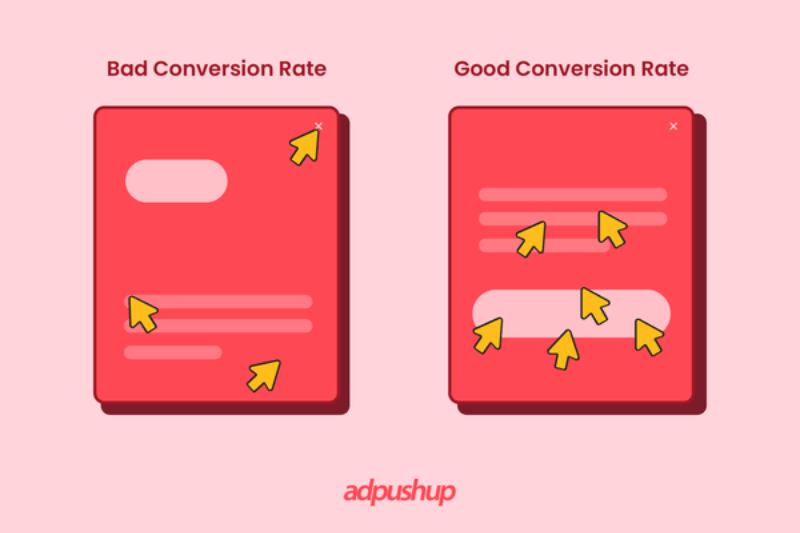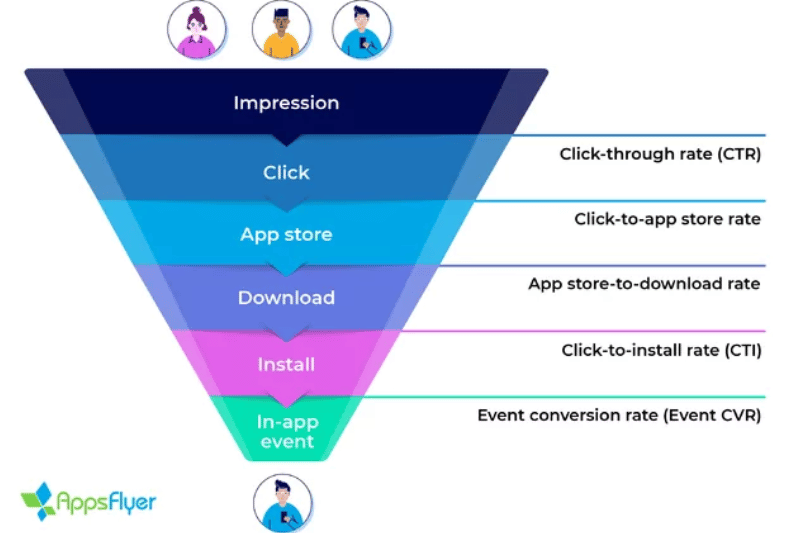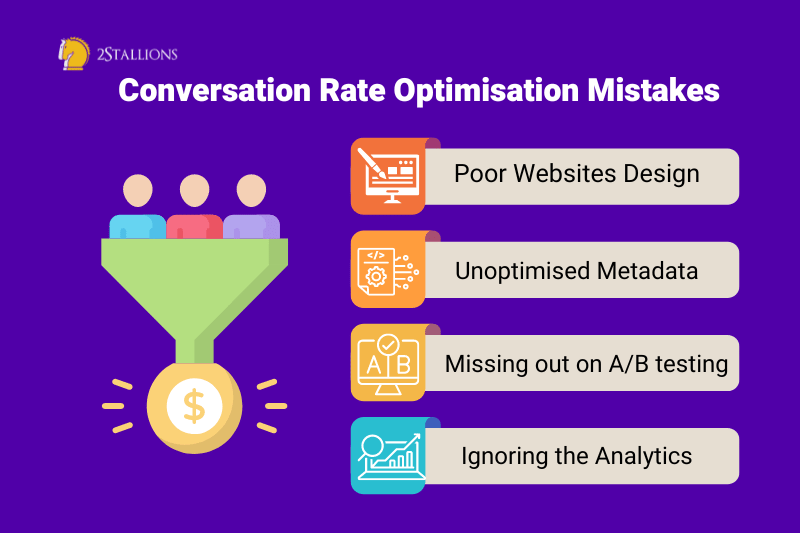SHARE

In today’s competitive digital landscape, it is more important than ever for businesses to focus on improving their conversion rate optimisation. By understanding the basics of conversion rate optimisation and implementing key strategies, businesses can increase their chances of converting visitors into valuable customers.
In this article, we will explore the importance of conversion rate optimisation, key elements to consider, strategies to improve your conversion rates, and how to measure success. Additionally, we will address common challenges businesses face and provide solutions to overcome them. Let’s get started.
Understanding The Basics of Conversion Rate Optimisation
Before diving into the world of conversion rate optimisation, it’s essential to understand what it is exactly. Conversion rate optimisation, commonly called CRO, is improving your website or landing page to increase the percentage of visitors who convert into customers or complete a desired action.This may include making design changes, enhancing user experience, or refining your marketing strategies.
Conversion rate optimisation focuses on analysing user behaviour and making data-driven decisions to improve your website’s conversion rates. By understanding your audience and their preferences, you can optimise your site to cater to their needs and increase the likelihood of conversions.But let’s delve deeper into the world of conversion rate optimisation. Imagine you have a website that sells handmade jewellery.
You’ve put in a lot of effort to create a visually appealing website with stunning product images and detailed descriptions. However, despite the traffic you’re getting, you’re seeing fewer sales than you’d like. This is where conversion rate optimisation comes into play.
One of the first steps in CRO is analysing your website’s data. You can use tools like Google Analytics to gain insights into user behaviour, such as bounce rate, time spent on a page, and conversion funnels. By understanding how users interact with your website, you can identify areas that need improvement. For example, through data analysis, you may discover that many users abandon their shopping carts before completing the purchase.
This could be due to a complicated checkout process or unexpected shipping costs. Armed with this information, you can make targeted changes to address these issues and increase the chances of conversion.Another aspect of conversion rate optimisation is user experience. Put yourself in your customers’ shoes and think about their journey on your website.Is the navigation intuitive? Are the buttons and links visible? Is the content easy to read and understand? Improving the user experience can create a seamless journey that guides visitors towards conversion.
Furthermore, conversion rate optimisation is not a one-time process. It requires continuous monitoring and testing. A successful CRO strategy involves A/B testing, comparing two webpage versions to see which performs better.By testing different elements, such as headlines, call-to-action buttons, or colour schemes, you can make informed decisions based on data and gradually improve your conversion rates.
So why is conversion rate optimisation important for your business? Let’s consider the impact it can have on your profitability. By increasing the number of visitors who convert into customers, businesses can generate more revenue without increasing their marketing spend. It allows businesses to make the most out of their existing traffic and improve their return on investment.
Moreover, conversion rate optimisation can also help you gain a competitive edge. In today’s digital landscape, where customers have numerous options, providing a seamless and user-friendly experience can set you apart. By continuously improving your website’s conversion rates, you can attract and retain more customers, ultimately boosting your business’s success.
Key Elements of Conversion Rate Optimisation
There are several vital elements to consider when improving your conversion rates. These elements significantly shape the user experience and determine whether visitors will complete a desired action on your site. One vital element to focus on is the content of your website. High-quality and engaging content can capture the attention of your visitors and keep them interested in what you offer. You can build trust and credibility with your audience by providing valuable information, addressing their pain points, and offering solutions.
Another crucial element is website design, which optimises conversion rate. A well-designed and visually appealing website can create a positive first impression, build trust with visitors, and encourage them to explore further. It is important to consider straightforward navigation, intuitive layout, and compelling visuals to create a seamless user experience.
Furthermore, user experience (UX) is another vital element to consider when improving conversion rates. A positive user experience involves providing users with a seamless and enjoyable journey throughout your website. This may include reducing loading times, optimising mobile responsiveness, and simplifying checkout. By prioritising UX, you can enhance user satisfaction and increase the chances of conversions.
Additionally, social proof can also significantly impact conversion rates. When visitors see positive reviews, testimonials, or case studies from satisfied customers, they are more likely to trust your brand and purchase. Incorporating social proof elements, such as customer testimonials or trust badges, can help build credibility and influence the decision-making process.
Moreover, personalisation is becoming increasingly crucial in conversion rate optimisation. Tailoring your website content and offers to match the preferences and needs of individual visitors can significantly increase the likelihood of conversions. By leveraging data and analytics, you can gather insights about your audience and deliver personalised experiences that resonate with them.
Lastly, optimising your website for search engines is crucial for driving organic traffic and improving conversion rates. You can increase your website’s visibility in search engine results by implementing effective SEO strategies, such as keyword research, on-page optimisation, and link building. This, in turn, can attract more qualified visitors who are more likely to convert.
Strategies To Improve Your Conversion Rate Optimisation
Now that we understand the critical elements of conversion rate optimisation, it’s time to explore some strategies that can help improve your conversion rates. One strategy that has proven to be highly effective in improving conversion rates is implementing A/B testing. A/B testing involves creating two or more versions of a webpage and testing them with different segments of your audience to determine which version generates better results.
This lets you gather data and insights on user behaviour and preferences, helping you make informed decisions about your website design and content. When conducting A/B tests, it’s essential to focus on optimising various elements of your website. These can include headlines, call-to-actions, or layout variations. You can identify the most effective combinations and improve your conversion rates by continuously testing and optimising these elements.
Another crucial aspect of conversion rate optimisation is the impact of compelling call-to-actions (CTAs). A well-crafted CTA can be a powerful tool in guiding users towards the desired action, whether purchasing, subscribing to a newsletter, or filling out a form. When creating CTAs, making them visually appealing and eye-catching is essential. Using contrasting colours, bold fonts, or attention-grabbing graphics can help draw the user’s attention to the CTA. Additionally, keeping the CTA concise and action-oriented can increase its effectiveness.
Users should immediately understand what action they must take and why it benefits them. Furthermore, aligning your CTAs with the user’s needs and expectations is crucial. Understanding your target audience and their motivations can help you create CTAs that resonate with them.
For example, if your website offers a free trial of a software product, your CTA could emphasise the benefits of the trial and how it can solve the user’s problems. By implementing these strategies and continuously optimising your conversion rate optimisation efforts, you can increase the likelihood of converting website visitors into customers or leads. Remember, conversion rate optimisation requires constant monitoring, testing, and refinement to achieve the best results.
Measuring The Success of Your Conversion Rate Optimisation
Measuring and tracking the success of your conversion rate optimisation efforts is essential to understand what’s working and what needs improvement. By monitoring the right metrics and analysing your data, you can gain valuable insights into your website’s performance and make informed decisions to optimise your conversion rates.
Conversion rate optimisation is a continuous process that requires careful analysis and adjustment. It’s not enough to implement changes and hope for the best. You need to have a solid understanding of how your website performs and what factors influence your conversion rates.
One of the key metrics to track is the conversion rate itself. This metric tells you the percentage of visitors who take the desired action on your website, such as purchasing or filling out a form. Monitoring this metric over time lets you see if your optimisation efforts positively impact your conversion rates.
Essential Metrics to Track for Conversion Rate Optimisation
You should track several key metrics to measure your conversion rate optimisation success. These may include conversion rate, bounce rate, average session duration, and cart abandonment rate. By regularly monitoring these metrics, you can identify patterns, detect areas for improvement, and make data-driven adjustments to increase your conversion rates.
Bounce rate is another important metric to consider. It measures the percentage of visitors who leave your website without taking any further action. A high bounce rate could indicate that your website needs to be more engaging or visitors are not finding what they want. By analysing this metric, you can identify potential issues and make changes to improve user experience and encourage visitors to stay on your site.
Average session duration is another metric that can provide valuable insights into your website’s performance. It tells you how long, on average, visitors spend on your site. A longer average session duration could indicate visitors find your content interesting and engaging. On the other hand, a short average session duration may suggest that visitors need help finding what they’re looking for or that your website is challenging to navigate.
By analysing this metric, you can identify areas for improvement and make changes to keep visitors engaged for extended periods. The cart abandonment rate is a metric that applies explicitly to e-commerce websites. It measures the percentage of visitors who add items to their cart but leave without completing the purchase.
A high cart abandonment rate could indicate issues with your checkout process or pricing. By analysing this metric, you can identify potential barriers to conversion and make adjustments to improve the overall shopping experience.
Interpreting Your Conversion Rate Data
Interpreting your conversion rate data is crucial in understanding your website’s performance and the effectiveness of your optimisation efforts. It’s critical to analyse data trends and patterns, identify potential bottlenecks or areas of improvement, and make data-backed decisions to refine your strategies and achieve better conversion rates.
When interpreting your conversion rate data, looking beyond the numbers and considering the context is essential. For example, a sudden increase in conversion rate may be due to a specific marketing campaign or a change in website design. Understanding the factors influencing your conversion rates allows you to make more informed decisions and replicate successful strategies.
It’s also important to segment your data to gain deeper insights. By analysing conversion rates by traffic source, device type, or user demographics, you can identify specific areas for improvement and tailor your optimisation efforts accordingly. This level of granularity allows you to target specific audiences and create a more personalised user experience.
Furthermore, it’s crucial to monitor your conversion rate data over time. Conversion rates can fluctuate due to various factors, such as seasonality or changes in consumer behaviour. By tracking your data consistently, you can identify long-term trends and make strategic adjustments to maintain or improve your conversion rates. In conclusion, measuring the success of your conversion rate optimisation requires diligent monitoring and analysis of key metrics.
By understanding your website’s performance and interpreting your data effectively, you can make data-driven decisions to improve your conversion rates and ultimately drive more success for your online business.
Overcoming Common Challenges in Conversion Rate Optimisation
While conversion rate optimisation can yield significant benefits, businesses often face challenges. By being aware of these challenges and implementing effective solutions, you can overcome them and maximise your conversion rates.
Dealing With Low Traffic And Conversion Rates
Low traffic and conversion rates can hinder your conversion rate optimisation efforts. To overcome this challenge, you must drive targeted traffic to your website through search engine optimisation, social media marketing, or paid advertising. Additionally, improving your website’s visibility and accessibility through organic and paid search can help attract more potential customers and increase conversion opportunities.
How To Handle High Bounce Rates
High bounce rates can indicate that visitors need help finding what they’re looking for or encountering obstacles preventing them from engaging with your site.
To reduce bounce rates, consider improving your website’s load speed, making your content more engaging and relevant, and enhancing the overall user experience. By addressing these issues, you can encourage visitors to spend more time on your site and increase the chances of conversions.
Improving your conversion rate optimisation is an ongoing process that requires continuous monitoring, testing, and optimisation. Understanding the basics, implementing key strategies, and overcoming common challenges can significantly enhance conversion rates and drive business growth.
Remember, every conversion matters, and every small improvement can make a big difference in your bottom line. So, start implementing these strategies today and watch your conversion rates soar!
Frequently Asked Questions About Conversion Rate Optimisation
What Is Meant by Conversion Rate Optimisation?
Conversion Rate Optimisation (CRO) refers to the systematic process of increasing the percentage of website visitors who take a desired action, be it purchasing a product, signing up for a newsletter, or any other defined goal. It involves understanding how users navigate your site, their actions, and what’s stopping them from completing your goals.
How Do You Optimise Conversion Rate?
- Analyse User Behaviour: Use tools like Google Analytics and Heatmaps to understand how users interact with your website.
- A/B Testing: Test different versions of webpage elements (like CTAs, images, or headlines) to determine which performs better in conversions.
- Optimise Landing Pages: Ensure landing pages are clear, relevant, and designed to convert.
- Enhance User Experience (UX): Ensure your website is user-friendly, mobile-optimised, and easy to navigate.
- Clear Call-to-Actions (CTAs): Make sure your CTAs are clear, compelling, and prominently placed.
- Address Objections: Provide detailed product information, FAQs, and testimonials to alleviate concerns and build trust.
- Speed Up Page Load Times: A faster site can improve user experience and conversion rates.
Is Conversion Rate A Part Of SEO?
While conversion rate isn’t a direct ranking factor in SEO, the two are interrelated. A well-optimised site for SEO can drive more organic traffic. However, CRO ensures that this traffic is maximised for conversions. Furthermore, elements that improve user experience for CRO, like page speed, are essential for SEO.
Is Conversion Rate Optimisation A Part of Digital Marketing?
Yes, Conversion Rate Optimisation is an integral component of digital marketing. Digital marketing aims to drive traffic and conversions. CRO focuses explicitly on maximising the latter’s efficiency, ensuring that the traffic generated through digital marketing channels leads to successful conversions on the website.



